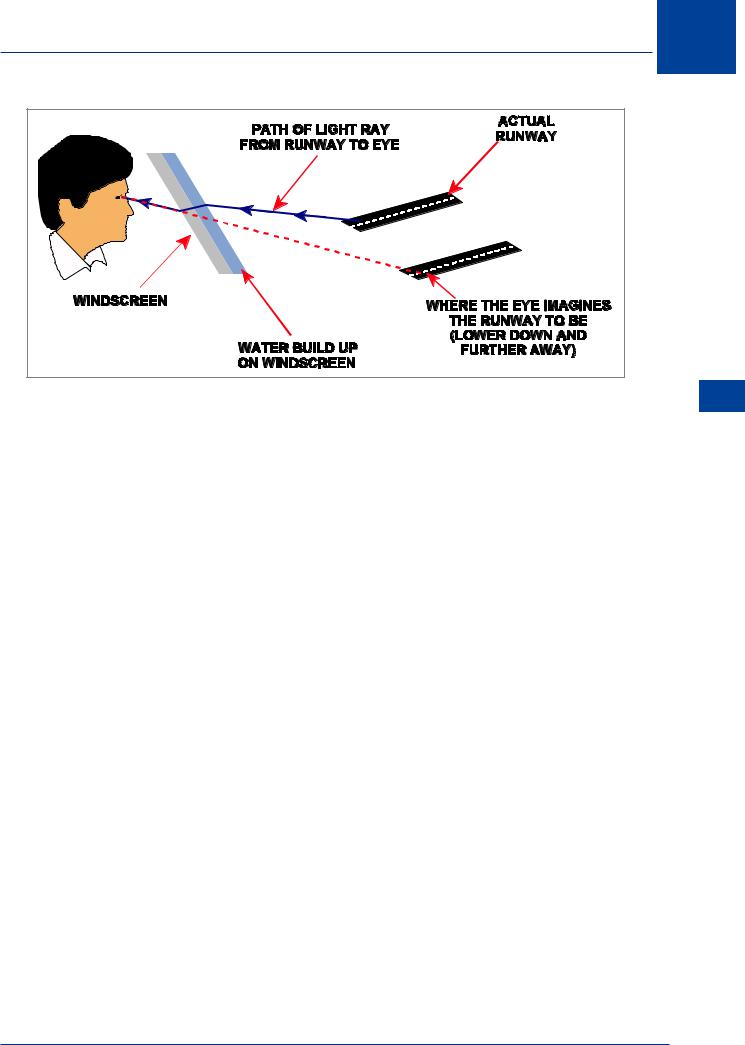
- •Textbook Series
- •Contents
- •1 Basic Concepts
- •The History of Human Performance
- •The Relevance of Human Performance in Aviation
- •ICAO Requirement for the Study of Human Factors
- •The Pilot and Pilot Training
- •Aircraft Accident Statistics
- •Flight Safety
- •The Most Significant Flight Safety Equipment
- •Safety Culture
- •Reason’s Swiss Cheese Model
- •The Five Elements of Safety Culture
- •Flight Safety/Threat and Error Management
- •Threats
- •Errors
- •Undesired Aircraft States
- •Duties of Flight Crew
- •2 The Circulation System
- •Blood Circulation
- •The Blood
- •Composition of the Blood
- •Carriage of Carbon Dioxide
- •The Circulation System
- •What Can Go Wrong
- •System Failures
- •Factors Predisposing to Heart Attack
- •Insufficient Oxygen Carried
- •Carbon Monoxide
- •Smoking
- •Blood Pressure
- •Pressoreceptors and their Function Maintaining Blood Pressure
- •Function
- •Donating Blood and Aircrew
- •Pulmonary Embolism
- •Questions
- •Answers
- •3 Oxygen and Respiration
- •Oxygen Intake
- •Thresholds of Oxygen Requirements Summary
- •Hypoxic Hypoxia
- •Hypoxic Hypoxia Symptoms
- •Stages/Zones of Hypoxia
- •Factors Determining the Severity of and the Susceptibility to Hypoxic Hypoxia
- •Anaemic Hypoxia
- •Time of Useful Consciousness (TUC)
- •Times of Useful Consciousness at Various Altitudes
- •Effective Performance Time (EPT)
- •Hyperventilation
- •Symptoms of Hyperventilation
- •Hypoxia or Hyperventilation?
- •Cabin Pressurization
- •Cabin Decompression
- •Decompression Sickness (DCS)
- •DCS in Flight and Treatment
- •Questions
- •Answers
- •4 The Nervous System, Ear, Hearing and Balance
- •Introduction
- •The Nervous System
- •The Sense Organs
- •Audible Range of the Human Ear and Measurement of Sound
- •Hearing Impairment
- •The Ear and Balance
- •Problems of Balance and Disorientation
- •Somatogyral and Somatogravic Illusions
- •Alcohol and Flying
- •Motion Sickness
- •Coping with Motion Sickness
- •Questions
- •Answers
- •5 The Eye and Vision
- •Function and Structure
- •The Cornea
- •The Iris and Pupil
- •The Lens
- •The Retina
- •The Fovea and Visual Acuity
- •Light and Dark Adaptation
- •Night Vision
- •The Blind Spot
- •Stereopsis (Stereoscopic Vision)
- •Empty Visual Field Myopia
- •High Light Levels
- •Sunglasses
- •Eye Movement
- •Visual Defects
- •Use of Contact Lenses
- •Colour Vision
- •Colour Blindness
- •Vision and Speed
- •Monocular and Binocular Vision
- •Questions
- •Answers
- •6 Flying and Health
- •Flying and Health
- •Acceleration
- •G-forces
- •Effects of Positive G-force on the Human Body
- •Long Duration Negative G
- •Short Duration G-forces
- •Susceptibility and Tolerance to G-forces
- •Summary of G Tolerances
- •Barotrauma
- •Toxic Hazards
- •Body Mass Index (BMI)
- •Obesity
- •Losing Weight
- •Exercise
- •Nutrition and Food Hygiene
- •Fits
- •Faints
- •Alcohol and Alcoholism
- •Alcohol and Flying
- •Drugs and Flying
- •Psychiatric Illnesses
- •Diseases Spread by Animals and Insects
- •Sexually Transmitted Diseases
- •Personal Hygiene
- •Stroboscopic Effect
- •Radiation
- •Common Ailments and Fitness to Fly
- •Drugs and Self-medication
- •Anaesthetics and Analgesics
- •Symptoms in the Air
- •Questions
- •Answers
- •7 Stress
- •An Introduction to Stress
- •The Stress Model
- •Arousal and Performance
- •Stress Reaction and the General Adaption Syndrome (GAS)
- •Stress Factors (Stressors)
- •Physiological Stress Factors
- •External Physiological Factors
- •Internal Physiological Factors
- •Cognitive Stress Factors/Stressors
- •Non-professional Personal Factors/Stressors
- •Stress Table
- •Imaginary Stress (Anxiety)
- •Organizational Stress
- •Stress Effects
- •Coping with Stress
- •Coping with Stress on the Flight Deck
- •Stress Management Away from the Flight Deck
- •Stress Summary
- •Questions
- •Answers
- •Introduction
- •Basic Information Processing
- •Stimuli
- •Receptors and Sensory Memories/Stores
- •Attention
- •Perception
- •Perceived Mental Models
- •Three Dimensional Models
- •Short-term Memory (Working Memory)
- •Long-term Memory
- •Central Decision Maker and Response Selection
- •Motor Programmes (Skills)
- •Human Reliability, Errors and Their Generation
- •The Learning Process
- •Mental Schema
- •Questions
- •Answers
- •9 Behaviour and Motivation
- •An Introduction to Behaviour
- •Categories of Behaviour
- •Evaluating Data
- •Situational Awareness
- •Motivation
- •Questions
- •Answers
- •10 Cognition in Aviation
- •Cognition in Aviation
- •Visual Illusions
- •An Illusion of Movement
- •Other Sources of Illusions
- •Illusions When Taxiing
- •Illusions on Take-off
- •Illusions in the Cruise
- •Approach and Landing
- •Initial Judgement of Appropriate Glideslope
- •Maintenance of the Glideslope
- •Ground Proximity Judgements
- •Protective Measures against Illusions
- •Collision and the Retinal Image
- •Human Performance Cognition in Aviation
- •Special Situations
- •Spatial Orientation in Flight and the “Seat-of-the-pants”
- •Oculogravic and Oculogyral Illusions
- •Questions
- •Answers
- •11 Sleep and Fatigue
- •General
- •Biological Rhythms and Clocks
- •Body Temperature
- •Time of Day and Performance
- •Credit/Debit Systems
- •Measurement and Phases of Sleep
- •Age and Sleep
- •Naps and Microsleeps
- •Shift Work
- •Time Zone Crossing
- •Sleep Planning
- •Sleep Hygiene
- •Sleep and Alcohol
- •Sleep Disorders
- •Drugs and Sleep Management
- •Fatigue
- •Vigilance and Hypovigilance
- •Questions
- •Answers
- •12 Individual Differences and Interpersonal Relationships
- •Introduction
- •Personality
- •Interactive Style
- •The Individual’s Contribution within a Group
- •Cohesion
- •Group Decision Making
- •Improving Group Decision Making
- •Leadership
- •The Authority Gradient and Leadership Styles
- •Interacting with Other Agencies
- •Questions
- •Answers
- •13 Communication and Cooperation
- •Introduction
- •A Simple Communications Model
- •Types of Questions
- •Communications Concepts
- •Good Communications
- •Personal Communications
- •Cockpit Communications
- •Professional Languages
- •Metacommunications
- •Briefings
- •Communications to Achieve Coordination
- •Synchronization
- •Synergy in Joint Actions
- •Barriers to Crew Cooperation and Teamwork
- •Good Team Work
- •Summary
- •Miscommunication
- •Questions
- •Answers
- •14 Man and Machine
- •Introduction
- •The Conceptual Model
- •Software
- •Hardware and Automation
- •Intelligent Flight Decks
- •Colour Displays
- •System Active and Latent Failures/Errors
- •System Tolerance
- •Design-induced Errors
- •Questions
- •Answers
- •15 Decision Making and Risk
- •Introduction
- •The Mechanics of Decision Making
- •Standard Operating Procedures
- •Errors, Sources and Limits in the Decision-making Process
- •Personality Traits and Effective Crew Decision Making
- •Judgement Concept
- •Commitment
- •Questions
- •Answers
- •16 Human Factors Incident Reporting
- •Incident Reporting
- •Aeronautical Information Circulars
- •Staines Trident Accident 1972
- •17 Introduction to Crew Resource Management
- •Introduction
- •Communication
- •Hearing Versus Listening
- •Question Types
- •Methods of Communication
- •Communication Styles
- •Overload
- •Situational Awareness and Mental Models
- •Decision Making
- •Personality
- •Where We Focus Our Attention
- •How We Acquire Information
- •How We Make Decisions
- •How People Live
- •Behaviour
- •Modes of Behaviour
- •Team Skill
- •18 Specimen Questions
- •Answers to Specimen Papers
- •Revision Questions
- •Answers to Revision Questions
- •Specimen Examination Paper
- •Answers to Specimen Examination Paper
- •Explanations to Specimen Examination Paper
- •19 Glossary
- •Glossary of Terms
- •20 Index

Cognition in Aviation 10
Figure 10.12 A visual illusion caused by a layer of water on the windscreen
Snow Coverage
Not only does snow lead to false height judgements it is often difficult to decide where the surface ends and the sky begins due to the absence of visual and focal clues. It is easy to mistake snow-covered mountains for clouds with catastrophic results.
Whiteout can be caused either by blowing snow, when visibility is reduced to zero and even taxiing is impossible or by extended exposure to the reflected glare of snow. The second cause can be most alarming since it manifests itself in the inability to distinguish ground features. The landscape appears to be a flat, smooth plane of white and accurate height assessment is rendered impossible. There is the added danger that snow may not reflect radar pulses so the high ground will not appear on the weather radar screen.
Fog, Haze, Pollution and LowVisibility
As a result of fog, haze or pollution, runway lights appear dim giving the impression that the runway is further away than it is which gives rise to steeper approaches than normal.
Runway Lights
The intensity of runway lights will also lead to errors. Their brightness or dimness will either give the false impression of the runway being either closer or more distant than it is. Thus incorrect approach angles and judgement of closing speeds are likely.
Spatial Orientation in Flight and the “Seat-of-the-pants”
As we saw in Chapter 4, the vestibular apparatus detects the orientation and movements only of the head. It is therefore essential that the nervous centres also receive information depicting the spatial orientation of the head with respect to the body as well as the spatial orientation of the different parts of the body with respect to each other. This information is transmitted by the proprioceptors which are components of the nervous system and are located under the skin (subcutaneous) in the neck and the major parts of the body. A pilot relying on these inputs is sometimes referred to as flying by the “seat-of-the-pants”.
The most important sense with regards to spatial orientation is sight. Even without the inputs from the vestibular apparatus, a person can still use his/her visual images of the outside world to maintain spatial orientation.
Cognition in Aviation 10
197

10 Cognition in Aviation
Aviation in Cognition 10
Under instrument conditions a pilot loses this vital visual input. For example, if the aircraft goes into a descent it will accelerate and this acceleration, via the otoliths, will inform the pilot that the aircraft is in the climb. The proprioceptors will also detect a climb because of the g-forces resulting from the somatogravic effect.
Thus these proprioceptive stimuli are completely unreliable when visual contact with the ground is lost or when flying IMC and must be ignored.
CROSS CHECK AND BELIEVE THE INSTRUMENTS
Oculogravic and Oculogyral Illusions
Whereas there are various differing definitions of these two illusions, it has been confirmed that the following (extracted from Fundamentals of Aerospace Medicine by R.L. Dehart), are accepted:
Oculogyral Illusion
Whereas a somatogyral illusion is a false sensation, or lack of sensation, experienced by a pilot undergoing angular motion, an oculogyral illusion is a false sensation of visual movement of an object viewed by a pilot. It is the visual sister to the somatogyral illusion. Thus the pilot experiencing an oculogyral illusion will see objects in front of him/her to be moving in the opposite direction. A very real danger is created when the somatogyral illusion is combined with the oculogyral illusion. In this case the pilot not only has the sensation of turning in the opposite direction due to the somatogravic illusion but this feeling is confirmed by his/her visual inputs - the very human sense that is known to be the most important as far as spatial orientation is concerned and therefore to be trusted.
Oculogravic Illusion
The oculogravic illusion occurs under the same conditions as the somatogravic illusion and is the direct visual result of linear acceleration. For example, a pilot subjected to deceleration experiences a nose-down pitch sensation because of the somatogravic illusion. Simultaneously, he/she observes the instrument panel to move downwards, confirming his/her sensation of tilting forward. Thus the oculogravic illusion is the visually apparent movement of an object in front of the observer that is actually in a fixed position relative to him/her.
198

Questions
Questions
1.If a runway slopes downwards, how does this affect the pilots’ approach?
a.It is likely to be too high
b.It is likely to be too low
c.It is likely to be too fast
d.It is likely to be too slow
2.If a runway slopes upwards, how does this affect the pilots’ approach?
a.It is likely to be too high
b.It is likely to be too low
c.It is likely to be too fast
d.It is likely to be too slow
3.What is the likely effect of a runway which is wider than expected?
a.Flaring too late and damaging the aircraft
b.Flaring too soon and causing a heavy landing
c.Approach speed much too high
d.Approach speed higher than usual
4.What approach conditions cause the “black hole effect”?
a.Landing at night in sleet or heavy rain
b.Landing at night with a partially lit runway
c.Landing at night with the cockpit instruments turned up too high
d.Landing at night when there are no lights between the aircraft and the runway
5.How does the “black hole effect” alter the pilots’ judgement of the approach?
a.Overestimation of height
b.Underestimation of height
c.Tends to make the approach much too fast
d.Tends to make the approach faster than normal
6.What are the main visual cues for rounding out?
a.Round out height and speed
b.Confirmation of decision height and closing speed
c.Closing speed and height check
d.Apparent speed of ground objects increases and texture of ground changes.
7.How do misty/foggy conditions affect the pilots judgement on the approach?
a.Underestimating range due to illusionary effect through cockpit glass
b.Underestimating range due to the lights appearing dim
c.Underestimating range due to illusionary effect through cockpit glass
d.Overestimating range due to the lights appearing dim
10
Questions 10
199

10 Questions
Questions 10
8.If two aircraft are on a line of constant bearing, what is the likely outcome?
a.Depends whether by day or by night
b.They will collide
c.There will be a near miss
d.It is quite safe and they will pass well clear of each other
9.How will an oncoming aircraft on a line of constant bearing appear visually?
a.There will be no relative movement and it will appear to be very small until seconds before the collision
b.There will be no relative movement and it will appear to be very small until seconds before the aircraft passes close by
c.There will be no relative movement and it will appear to be very small until seconds before the aircraft passes above
d.There will be no relative movement and it will appear to be very small until seconds before the aircraft passes well clear
10.What is the duration of a saccade and rest period?
a.0.3 seconds
b.0.5 seconds
c.0.013 seconds
d.1 second
11.What visual technique should be used when searching for an aircraft?
a.Sweep from side to side with the eyes covering the whole field of vision
b.Search the sky portion by portion starting on the left
c.Pinpoint 10° segments of the sky and confirm before passing onto another
d.Use a succession of small and rapid eye movements
12.Refraction, due to rain on the windscreen, makes the approach:
a.steeper
b.shallower
c.faster
d.slower
13.Expectation can affect perception.
a.True
b.False
14.The blooming effect of rain makes:
a.the runway appear closer
b.the runway appear further away
c.does not effect runway perception
d.the instruments difficult to read
200

Questions 10
15.What are the laws that the Gestalt Theory propose?
a.The laws of Perception
b.The laws of Perceptual Illusions
c.The laws of Perceptual Reception
d.The laws of Perceptual Organization
16.A visual scan should cover the sky in overlapping sections of:
a.5°
b.10°
c.15°
d.20°
17.The scanning technique should differ by day and night.
a.True
b.False
18.A distant aircraft is identified and remains on a constant relative bearing. You should:
a.wait until the aircraft appears to grow larger before taking avoiding action
b.take avoiding action if you do not have right of way
c.take immediate avoiding action
d.wait two seconds to reidentify and then take avoiding action
19.Another name for the illusion associated with acceleration is:
a.the somatogyral illusion
b.the somatogravic illusion
c.motion sickness
d.air sickness
20.If an illusion is known to be possible at a particular aerodrome, as Captain of the aircraft, you should:
a.say nothing as it might frighten the crew
b.ensure you brief the crew
c.report the fact to operations so that other crews are aware of the danger
d.report the fact to your operator so that other crews are aware of the danger
Questions 10
201
